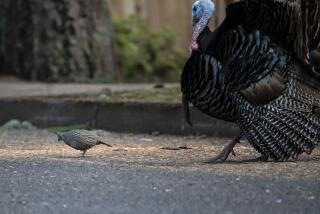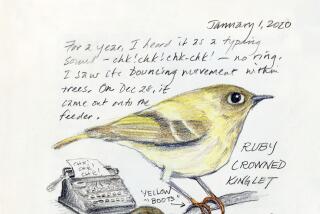Tweet Music : Researcher Studies Links Between Bird Song and Male-Female Behavior
- Share via
CLAREMONT — When the red, red robins go bob-bob bobbin’ along, he sings but she doesn’t. That’s the way it is with many species of birds throughout North America and Europe.
But in the case of their tropical counterparts, both the males and the females often sing.
In fact, with birds such as the Bay wren in Central America, they even create a duet of sorts, in a melodious, rapid-fire, high-pitched style.
She sings something like: “Meat-and-beans.”
He sings something like: “Chili-chili.”
To puzzle out how tropical birds learn to sing and to unravel the mysteries of gender differences in the songs, Rachel Levin is importing the Bay wren from the Panama rain forests.
The Pomona College biology assistant professor is even painstakingly raising the birds from eggs in a Claremont laboratory with soundproof cages.
Just as she has done in the decade since she was a Cornell University graduate student, Levin is exploding the often-repeated myth that only male birds sing.
The mistaken notion was developed, she says, by studies in temperate climates where species such as the robin abound. But these make up only 15% of the world’s bird species.
Levin’s findings, she says, may even point to the origins and roles that sexual differences play in human behavior.
She said that as a woman in the male-dominated profession of ornithology, if she can show that bird-song education is social, “it would create a stir because the people in the bird-song business are very chauvinistic.”
When she started all this, she said, “I never intended to be an uppity little snoot.”
Since 1982, Levin, 39, has been going to Panama, often for five months at a time, to study what she calls “one of the best singing wrens.”
Officially known as Thryothorus nigricapillus, the Bay wren has a chestnut brown body barred with black. It has a pale orange chest and a boldly marked black and white head. Adults are 5 1/2 inches long.
Shortly after sunup on a recent day, Levin punched the play buttons on a series of cassette players in her lab. Speakers are in the cages of the birds in an adjacent room.
“Singing 101,” she said. “It’s time for the birds to learn to sing.”
The tapes played recordings of adult male and female Bay wrens singing sunrise songs.
In the study, some birds will not hear songs. Some will hear only female songs. Some will hear only male songs. Others will hear solely duets.
She varies the selections and has enough recordings to last for a year of tutoring. “You can imagine what it would be like to listen to the same album day after day.”
Already, she says, she has been able to show that “tropical birds in general don’t use hormones to support behaviors like singing”--unlike all temperate birds that have been studied.
And she has found that Daddy doesn’t always sing bass. Nor are Daddy and Mommy forever married and singing “love duets.”
Duets, she said, “don’t have to be love songs. Everybody thinks birds are monogamous. They divorce and re-mate. They cheat.”
About 20% to 40% of the eggs in a tropical nest don’t belong to the man of the house.
Although she is discovering many variations in the rapid duets, she says, “it’s just wop-diddley-wop-diddley-wop. They don’t do ballads.”
One thing she has learned is that the female starts duets and will sing even if males don’t join in. “When she sings alone, she spaces her songs as if he were singing too, which is kind of cool--to my own perverted way of thinking.”
Beyond that, Levin said, the female and male don’t necessarily have to be mates for the songs to be in sync.
The female sings to defend her territory. The male provides an answer to all who listen: “She’s mine.”
As Levin researches the nature-versus-nurture questions, she is asking: “Is the singing under hormonal control, genetic control or is it learned behavior?”
She asked,”You are a kid in a nest. How do you separate a duet into two parts of male and female and figure out what sex you are and which part you have to learn?”
She uses a computer program that produces graphics of songs, showing the pitch and pattern changes in male and female notes.
The males often repeat notes. Females don’t. “You’d need something like a flute to play a Bay wren song.” In the jungle, she said, the song “is quite noticeable.”
“The way birds learn to sing is very much like what kids do: They listen and don’t talk. There is a stage when they sing, perhaps months later, when it would sound awful.” Eventually, they sing--like a bird.
Bringing the birds from the jungle and raising them in a lab has been a nightmare, she said.
The first difficulty is finding a nest with eggs, because 80% of them are eaten by snakes or predators like the coatimundi. A pair of birds might have a territory covering 200 yards by 100 yards, with several nests but only one with eggs.
Although both sexes feed the children and both build the nests, males sleep in different nests from the females and babies.
To find the nest, Levin must find a female. The trick is determining the sex.
First, she must catch a bird in mist nets. She makes an incision and shines a flashlight in to see if there are testes or ovaries. Then she closes the incision and releases the bird so she can track it later--by following a colored band she puts on the leg or by following it by its song, keyed to its sex.
As she talked, she retrieved a nest to show its exquisite design. Made of wispy plant fibers, it had a tunnel-like entrance.
Although it may sound romantic to work in the rain forest, she said, it is hard. “It’s muggy. You’re getting stung by insects. You’re looking for these little brown birds in dense green jungle.”
And there are poisonous snakes in abundance--the fer-de-lance and the bushmaster.
But “it’s a spectacular place. You see shiny butterflies as big as a dinner plate. There are monkeys flying in the trees. You don’t have to be a biologist to go, ‘Wow!”’
Once the eggs are found, the problem is to keep them warm. “You hold them against your skin or put them in your bra. Then you put them in an incubator and drive very carefully.”
On the long journey back to Claremont, she has had harrowing times. Last summer, she was feeding a fragile wren she stored in an cat carrier under her seat.
Her seat mates on the flight, “two little old ladies,” were amazed to see her feeding the baby bird, all pink and tiny feathers. “It’s dying,” she told them.
With that, she said, “the whole plane got into it.” A steward rushed to get Perrier water and to pray for the bird, named Teeter because it was teetering on the edge.
The bird survived. Now she is a prized singing student.
More to Read
Sign up for Essential California
The most important California stories and recommendations in your inbox every morning.
You may occasionally receive promotional content from the Los Angeles Times.










